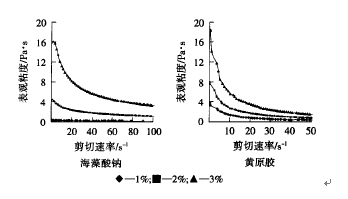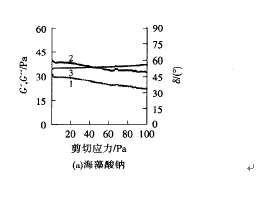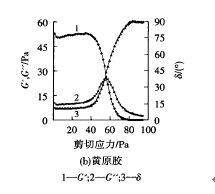Abstract: The viscoelastic properties of sodium alginate and xanthan gum paste were studied by steady shear and small amplitude shear stress scanning tests. The results showed that compared with sodium alginate, xanthan gum had high viscosity at low dosage and low shear rate, and showed remarkable "shear thinning" characteristics of pseudoplastic fluid. Sodium alginate is mainly viscous, showing more liquid-like characteristics, while xanthan gum is mainly elastic, showing more solid-like characteristics. With the increase of shear stress, the viscoelasticity of sodium alginate is relatively stable. The loss modulus is always greater than the storage modulus. The loss angle is greater than 45°, which mainly shows viscous behavior. The viscoelastic properties of xanthan gum have experienced The catastrophic region with high elastic to viscous transformation has a storage modulus greater than the loss modulus before the mutation, and the loss angle is less than 45°, showing a very significant elastic behavior.
Key words: sodium alginate; xanthan gum; rheological properties; viscoelastic properties
Study on the viscoelastic behaviors of sodium alginate and
Xanthan gum paste
WANG Li-li,MIN Jie,SHEN Qiu-hui,LI Jian-li,Li Chang-jie
Abstract:By means of steady shear and oscillation stresss weep tests, the viscoelastic properties of sodium alginate and xanthan gum paste were studied The results showed that compared with sodium alginate. Xanthan gum had high viscosity at low concentrations and low shear rates. And spreadsheet prominent shear-thinning behaviors of pseudoplastic fluids. Sodium alginate was dominated by viscous effect, and showed more liquid-like characteristic. While xanthan gum was dominated by elastic effect, and showed more solid-like characteristic. With the increase of shear stress,sodium alginate first stable viscous behavior. While thevis coelasticity of xanthan gum experienced amutational changezone from high elasticity to viscosity. Before the change the storage modulus was higher than loss modulus and the loss angle was less than 45°, and xanthan gum exhibit distincte lastic behavior.
Keywords:sodium alginate;xanthan gum;rheological propetries;viscoelastic properties
4. Paste is an important part of the printing paste, which determines the running performance of the printing, the color of the dye surface, the sharpness of the outline of the pattern, etc. Therefore, according to the dye properties, printing methods, pattern structure and fabric varieties, choose the appropriate paste. [1] When selecting a paste, in addition to considering its chemical properties and ionic properties, physical properties (most importantly rheology) should also be considered. Rheology is the property of deformation and flow of a substance under the action of force. It is divided into static method and dynamic method. The static method is to observe the change of material strain with time under the step stress load [2] , while the dynamic method is to apply a continuous sinusoidal stress or strain to the material, and then record the response of the material. [3] People have always attached great importance to the relationship between rheological properties and application properties of printing pastes. However, the static method is used to study the viscosity change of pastes at different shear rates and at different shear rates. The ratio of the viscosity values ​​below, and the lack of the necessary instruments to systematically study the dynamic viscoelastic behavior of the paste. The advantage of the dynamic method is that it can continuously apply small stress or strain to the paste over a wide frequency range, which can further characterize the viscoelastic properties of the paste. In dynamic rheological testing, many important information about the paste can be obtained, such as storage modulus G', loss modulus G", and complex viscosity.  * and loss angle
* and loss angle  Etc. These are important parameters for studying the viscoelastic properties of pastes.
Etc. These are important parameters for studying the viscoelastic properties of pastes.
Sodium alginate and xanthan gum are two common natural high molecular polymers in natural pastes, but the physical and chemical properties of the two are quite different. In this paper, the steady-state shear and small-oscillation shear stress scanning tests are performed by apparent viscosity.  a , storage modulus G', loss modulus G", loss angle
a , storage modulus G', loss modulus G", loss angle  And the change of composite viscosity field to explore the change of viscoelastic properties of sodium alginate and xanthan gum paste.
And the change of composite viscosity field to explore the change of viscoelastic properties of sodium alginate and xanthan gum paste.
1 test
1.1 Materials and Instruments
Drugs: Xanthan gum KELZANs (m industry grade, US CPKELCO company), high molecular weight sodium alginate (industrial grade, Shandong Jiejing Group Co., Ltd.).
Instruments: 85-2 thermostatic magnetic stirrer (Shanghai Sile Instrument Co., Ltd.), PL602-S-type electronic balance (Shanghai METTLER TOLEDO Instrument Co., Ltd.), StressTech rheometer (Swedish Reologica Rheology Company) .
1.2 Preparation of sodium alginate and xanthan gum paste
The beaker containing the quantitative distilled water is placed on a constant temperature magnetic stirrer, and the quantitative paste is slowly added while stirring, and stirred for a certain period of time to make it uniform and transparent. Allow to stand overnight, so that the paste is fully puffed, that is, a certain amount of the original paste is obtained.
1.3 Paste viscoelasticity test [4]
(1) Steady-state shear test - static viscosity performance: Select the cone plate in the RheoExplorer system of the rheometer, zero calibration, set temperature 25 ° C, shear rate 1-100S -1 scan 60 points, each After scanning for 10s, the normal force is zero, the test is started, and the data is recorded.
(2) Small oscillation shear stress scanning test - dynamic viscoelastic energy: Select the cone plate in the RheoExplorer system of the rheometer, zero calibration, set temperature 25 ° C, frequency setting 1 Hz, shear stress setting 0 .1~100Pa, scan 60 points, scan l0s for each point, after the normal force returns to zero, start testing and record data.
2 results and discussion
2.1 Static viscosity properties of sodium alginate and xanthan gum paste
It can be seen from Fig. 1 that compared with sodium alginate, xanthan gum has a higher apparent viscosity at low dosage and low shear rate, and shear thinning characteristics are more significant, especially 1% (paste) When the material quality is), sodium alginate is close to Newtonian fluid, and xanthan gum has the remarkable characteristic of shearing and thinning of pseudoplastic fluid. This difference is related to the molecular structure of the two pastes. Sodium alginate is a random block copolymer with a relative molecular mass of 32,000-200,000 and a theoretical molecular mass of 198.11 [5-7] , which is a non-chemical cross-linked structure. Xanthan gum is a structural polymer of "pentaose repeating unit", which contains a tertiary structure with an average molecular mass of 2 x 10 6 -5x10 7 [8] . The molecular chain itself is hard and strong, and the intermolecular force is strong. In solution, xanthan gum forms aggregated structures through intramolecular and intermolecular non-covalent and inter-molecular entanglement, with a highly entangled network structure, coupled with hard and straight molecular chains, making it low and low. High viscosity at shear rate. Compared with xanthan gum, in the aqueous solution, the molecular structure of sodium alginate is less entangled, and the structural viscosity is significantly lower than that of xanthan gum. Therefore, the sodium alginate paste with a dosage of 1% is close to the characteristics of Newtonian fluid.
In addition, as the amount of printing paste increases, its apparent viscosity Gradually increasing, shear thinning characteristics are also becoming more and more significant. Because the amount of paste increases, the sol system contains more hydrophilic groups, and the molecules are easily entangled into a regular network structure by hydrogen bonding and van der Waals force, and more free water is wrapped to make the paste solution. The viscosity of the structure becomes larger, so the amount of the paste is larger, and the pseudoplasticity is also significant.

Figure 1. Apparent viscosity-shear rate curve of different printing pastes
2.2 Dynamic viscoelastic properties of sodium alginate and xanthan gum paste
Test to determine storage modulus G', loss modulus G", loss angle  The viscous and complex viscosity changes with shear stress, reflecting the viscoelastic properties of sodium alginate and xanthan gum paste. The storage modulus G' refers to the ability of the paste system to store energy in one cycle under the action of alternating stress, which usually represents the elasticity of the paste [9] . The larger the value, the greater the elasticity of the paste. The loss modulus G" refers to the ability of the paste system to consume energy in a change cycle, usually representing the viscosity of the paste. The smaller the value, the better the viscous flow of the paste (4), which can be used to judge whether the paste is in The liquid-like state is still a solid state. When the paste is in a liquid-like state, its storage modulus G' is much smaller than the loss modulus G"; when the paste is in a solid state, its storage modulus G' is large Loss modulus G"tan
The viscous and complex viscosity changes with shear stress, reflecting the viscoelastic properties of sodium alginate and xanthan gum paste. The storage modulus G' refers to the ability of the paste system to store energy in one cycle under the action of alternating stress, which usually represents the elasticity of the paste [9] . The larger the value, the greater the elasticity of the paste. The loss modulus G" refers to the ability of the paste system to consume energy in a change cycle, usually representing the viscosity of the paste. The smaller the value, the better the viscous flow of the paste (4), which can be used to judge whether the paste is in The liquid-like state is still a solid state. When the paste is in a liquid-like state, its storage modulus G' is much smaller than the loss modulus G"; when the paste is in a solid state, its storage modulus G' is large Loss modulus G"tan  Characterize the relative size of the viscoelastic properties of the paste. [l1]
Characterize the relative size of the viscoelastic properties of the paste. [l1]  <45°. G'> G", the elasticity of the paste is greater than the viscosity, showing a more pronounced solid-like characteristic;
<45°. G'> G", the elasticity of the paste is greater than the viscosity, showing a more pronounced solid-like characteristic;  >45°, G">G', the viscosity of the paste is greater than the elasticity, showing a more pronounced liquid-like character;
>45°, G">G', the viscosity of the paste is greater than the elasticity, showing a more pronounced liquid-like character;  At =45°, G"=G', the ratio of the elasticity and viscosity of the paste is equal, and it is a critical transition state of solid and liquid-like. The composite viscosity egg and frequency, storage modulus and loss modulus are very large. The mutual relationship [12] is the result of the combined action of energy storage viscosity η" (representing elastic contribution) and dynamic viscosity η' (representing viscosity contribution).
At =45°, G"=G', the ratio of the elasticity and viscosity of the paste is equal, and it is a critical transition state of solid and liquid-like. The composite viscosity egg and frequency, storage modulus and loss modulus are very large. The mutual relationship [12] is the result of the combined action of energy storage viscosity η" (representing elastic contribution) and dynamic viscosity η' (representing viscosity contribution).
2.2.1 Relationship between modulus, loss angle and shear stress
It can be seen from Fig. 2(a) that as the shear stress increases, the storage modulus G" of sodium alginate is always greater than the loss modulus C, and the loss angle  More than 45 °, indicating that under the action of shear stress, the viscosity of sodium alginate is always greater than the elasticity, mainly showing viscous behavior. The shear stress is in the range of 0-20 Pa, and the G', G" of sodium alginate increases with the increase of shear stress.
More than 45 °, indicating that under the action of shear stress, the viscosity of sodium alginate is always greater than the elasticity, mainly showing viscous behavior. The shear stress is in the range of 0-20 Pa, and the G', G" of sodium alginate increases with the increase of shear stress.  Basically unchanged, going through a platform area, this is the linear viscoelastic region of sodium alginate, because under the action of shear stress, the molecular chain of sodium alginate will be automatically untwisted along the direction of shear stress, and the molecular The inter-hydrogen bond and van der Waals force are intertwined, and the shear stress is not enough to completely destroy the structure of the sodium alginate sol system. The molecular chain untangling and entanglement rate are basically equal, so the G' of sodium alginate , G",
Basically unchanged, going through a platform area, this is the linear viscoelastic region of sodium alginate, because under the action of shear stress, the molecular chain of sodium alginate will be automatically untwisted along the direction of shear stress, and the molecular The inter-hydrogen bond and van der Waals force are intertwined, and the shear stress is not enough to completely destroy the structure of the sodium alginate sol system. The molecular chain untangling and entanglement rate are basically equal, so the G' of sodium alginate , G",  Basically unchanged. The shear stress is within 20100Pa. With the increase of shear stress, the G' and G" of sodium alginate decrease slowly, indicating that the elasticity and viscosity of sodium alginate decrease slightly in this range.
Basically unchanged. The shear stress is within 20100Pa. With the increase of shear stress, the G' and G" of sodium alginate decrease slowly, indicating that the elasticity and viscosity of sodium alginate decrease slightly in this range.  Slowly rising, indicating that the viscous proportion of sodium alginate increased slightly in this range; however, the changes of G', G", and 6 were not large, indicating the viscoelasticity of sodium alginate under the action of higher shear stress. The energy is still relatively stable. As the shear stress continues to increase, the molecular chain of sodium alginate is oriented along the direction of shear stress, the rate of unwinding is greater than the rate of entanglement, and the network structure of the system is destroyed, so that sodium alginate The elasticity and viscosity are slightly reduced.
Slowly rising, indicating that the viscous proportion of sodium alginate increased slightly in this range; however, the changes of G', G", and 6 were not large, indicating the viscoelasticity of sodium alginate under the action of higher shear stress. The energy is still relatively stable. As the shear stress continues to increase, the molecular chain of sodium alginate is oriented along the direction of shear stress, the rate of unwinding is greater than the rate of entanglement, and the network structure of the system is destroyed, so that sodium alginate The elasticity and viscosity are slightly reduced.
It can be seen from Fig. 2(b) that the shear stress is in the range of 0 to 40 Pa, and the storage modulus G' of xanthan gum is much larger than the loss modulus G", and the loss angle  Far less than 45°, and with the increase of shear stress, G', G" of xanthan gum,
Far less than 45°, and with the increase of shear stress, G', G" of xanthan gum,  It is almost constant, indicating that the viscoelastic properties of xanthan gum are very stable in this range, and its elasticity is much greater than the viscosity, showing a very significant elastic behavior. From the molecular structure of xanthan gum, it forms a multi-helical network in aqueous solution, which makes the main chain less susceptible to shear stress damage, keeping the viscoelastic properties of the xanthan gum paste unaffected, and at the same time sufficient At high dosages (>1%), the xanthan gum dispersion exhibits weak gel properties [13] and exhibits good elastic behavior. The shear stress is in the range of 40-80 Pa. With the increase of shear stress, the G' of xanthan gum gradually decreases to the minimum value, and G" gradually increases to the maximum value (25 pa) and then gradually decreases to the minimum value (2pa). ), 8 gradually rises to a maximum of 90 °, indicating that the viscoelastic properties of xanthan gum in this range have undergone a mutation from high elasticity to high viscosity; when the shear stress reaches a certain value (about 58 Pa), the xanthan gum G' is equal to G" (G" reaches the maximum value,
It is almost constant, indicating that the viscoelastic properties of xanthan gum are very stable in this range, and its elasticity is much greater than the viscosity, showing a very significant elastic behavior. From the molecular structure of xanthan gum, it forms a multi-helical network in aqueous solution, which makes the main chain less susceptible to shear stress damage, keeping the viscoelastic properties of the xanthan gum paste unaffected, and at the same time sufficient At high dosages (>1%), the xanthan gum dispersion exhibits weak gel properties [13] and exhibits good elastic behavior. The shear stress is in the range of 40-80 Pa. With the increase of shear stress, the G' of xanthan gum gradually decreases to the minimum value, and G" gradually increases to the maximum value (25 pa) and then gradually decreases to the minimum value (2pa). ), 8 gradually rises to a maximum of 90 °, indicating that the viscoelastic properties of xanthan gum in this range have undergone a mutation from high elasticity to high viscosity; when the shear stress reaches a certain value (about 58 Pa), the xanthan gum G' is equal to G" (G" reaches the maximum value,  It is equal to 45°, and its elastic component and viscous component account for the same proportion. This point is the sudden change of xanthan gum from solid-like to liquid-like. The reason is that when the shear stress increases to a certain value, as the shear stress increases, the transient bond between the xanthan gum chains through the entanglement of the helical chain, the chain end, and the disordered chain is gradually destroyed. The direction of shear stress is rapidly oriented to produce viscous flow to lose energy. Therefore, the viscosity of the xanthan gum system gradually becomes larger, the elasticity gradually becomes smaller, and gradually changes to a liquid-like state. Shear stress is in the range of 80-100Pa, and G', G" of xanthan gum
It is equal to 45°, and its elastic component and viscous component account for the same proportion. This point is the sudden change of xanthan gum from solid-like to liquid-like. The reason is that when the shear stress increases to a certain value, as the shear stress increases, the transient bond between the xanthan gum chains through the entanglement of the helical chain, the chain end, and the disordered chain is gradually destroyed. The direction of shear stress is rapidly oriented to produce viscous flow to lose energy. Therefore, the viscosity of the xanthan gum system gradually becomes larger, the elasticity gradually becomes smaller, and gradually changes to a liquid-like state. Shear stress is in the range of 80-100Pa, and G', G" of xanthan gum  Almost unchanged, G' is close to 0Pa, and 8 is nearly 90° very close to the characteristics of liquid.
Almost unchanged, G' is close to 0Pa, and 8 is nearly 90° very close to the characteristics of liquid.


Printing paste 3% (for slurry quality) (the same below)
Figure 2 Modulus/loss angle-shear stress curve of printing paste
2.2.2 Relationship between complex viscosity and shear stress
The composite viscosity-shear stress curve of the printing paste is shown in Figure 3.

Figure 3 Composite viscosity-shear stress curve of printing paste
It can be seen from Fig. 3 that sodium alginate and xanthan gum paste have completely different viscosity change characteristics during shear stress. The composite viscosity of the sodium alginate paste subjected to shear stress is relatively stable, and the composite viscosity of the xanthan gum paste has undergone a mutation zone. At high shear stress (>80Pa), sodium alginate still has a high complex viscosity (6.5Pa·s), while the composite viscosity of xanthan gum becomes very small (0.4Pa·s).
3 conclusions
(1) Compared with sodium alginate paste, xanthan gum paste has high viscosity at low dosage and low shear rate, and shear thinning characteristics are more significant.
(2) Sodium alginate and xanthan gum paste with similar viscosity show completely different viscoelastic behavior during shear stress. With the increase of shear stress, the viscoelasticity of sodium alginate is relatively stable, the loss modulus is always greater than the storage modulus, the loss angle is greater than 45°, mainly exhibits viscous behavior, and the shear stress 020Pa is sodium alginate paste. Linear viscoelastic area. With the increase of shear stress, the viscoelastic properties of xanthan gum experienced a transition region from high elasticity to viscosity. Before the mutation, the storage modulus is larger than the loss modulus, and the loss angle is less than 45°, which is very significant. Flexible behavior. When the shear stress is >80Pa, the sodium alginate still has a large viscosity, while the xanthan gum is close to the liquid behavior.
references:
[l] Hu Pingyu. Printing process design and implementation (2) [J] _ printing and dyeing, 2008 (22): 41-43.
[2] Zhou Changjing, Li Huabin. Study on rheological and viscoelastic properties of hydrophobically associating polymer solutions [D]. Sichuan: Southwest Petroleum University, 2006: 4-43.
[3] Yang Ren Party, Chen Kefu. Dynamic viscoelastic properties of bagasse alkali pulping waste liquid polymer [J]. Journal of South China University of Technology: Natural Science Edition, 2003, 31(4): 93-96.
[4] Liu Baojiang, Qi Jie. Study on rheological properties of printing paste [D]. Shanghai: Donghua University, 2008: l3 - l5.
[5]GOMBOTZWR, WEESF. Proteinreleasefromlaginatematrices[J].
AdvancedDrugDeliveyReviews, 1998, 31: 267-285.
[6] HAGENA, SKJAKBG, DORNISHM. Pharmaeokineticsofsodiumalginateinmice [J]. EuropeanJournalofPharmaceuticalSciences, 1996'4(1):100.
[7]NAGASAWAN, MITOMOH, YOSHIIF, et port f. Radiation-induceddegr-adationofsdoiumalginate[J]. PolymerDegradetionandStability, 2000, 69(3): 279-285.
[8] Zhao Dajian, Yang Jianhua, Yu Xianchao, et al. The molecular weight of xanthan gum is å½. Applied Chemistry, 1989, 6(5): 86-89.
[9] Hou Jirui, Liu Zhongchun, Zhang Shufen, et al. The effect of alkali on the molecular morphology and rheological properties of polyacrylamide [J]. Acta Physico-Chimica Sinica, 2003, 19(3): 256-259.
[10] Pan Ding, Xu Haifeng. Rheological properties of PAN carbon fiber precursor silk spinning dope [D]. Shanghai: Donghua University, 2009: 35-37.
[l1] Liu Yahui, Li Chuanxian. Rheological study near the freezing point of crude oil [D]. Beijing: China University of Petroleum. 2009: 4-14.
[12] WINTERHH, CHAMBONF. Anlaysisoflinearviscoelasticityofa
eorsslinkingpolymeratthegelpointIJ]. JournalofP&eology, 1986, 30:
367-382.
[l3] Zhou Shenghua, Zhang Hongbin. Study on the conformational transformation and rheological study of xanthan gum in aqueous solution
[D]. Shanghai: Shanghai Jiaotong University, 2008:
Mower Blade,4t Mower Blade,Mower Cutter
Diamond Segment,Diamond Saw Blade,Diamond Wire Saw Co., Ltd. , http://www.nsblades.com